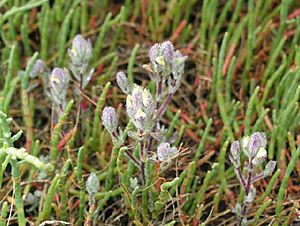Chloropyron molle facts for kids
Quick facts for kids Chloropyron molle |
|
|---|---|
 |
|
| Chloropyron molle subsp. molle | |
| Conservation status | |
| Scientific classification | |
| Genus: |
Chloropyron
|
| Species: |
molle
|
Chloropyron molle is a special kind of flowering plant. It's part of the Orobanchaceae family, which includes many interesting plants.
Contents
About the Soft Bird's Beak
This plant is found only in California, making it endemic to the state. It grows in wet, salty areas called salt marshes, especially near the Sacramento-San Joaquin River Delta and other parts of the Central Valley.
The Chloropyron molle plant usually looks grayish or purplish-green. It's an annual, meaning it lives for only one growing season. Its stems and leaves are covered in long, whitish hairs, and sometimes they can feel a bit bristly or sticky. The plant's flowers grow in a woolly cluster called an inflorescence. These are club-shaped white flowers, and they are wrapped inside very hairy leaf-like parts called sepals.
Two Special Subspecies
There are two main types, or subspecies, of Chloropyron molle, and both are quite rare. One of them is even protected by law because it's so uncommon.
Hispid Bird's Beak
One subspecies is called Chloropyron molle subsp. hispidus, also known as the hispid bird's beak. This plant likes to grow in very salty soils found in marshes and flat, dry areas called 'playas' (which are like inland salt flats). You can find it in different spots across the Central Valley. Sadly, much of its original home in the southern valley has been turned into farmland. This has caused many of its populations to disappear from those areas.
Soft Bird's Beak
The other subspecies, Chloropyron molle subsp. molle, is even rarer. It's known as the soft bird's beak. This one only grows in the salty marshes and wet areas near the inner San Francisco Bay Area and the delta. Because it's so rare, the United States government has listed it as an endangered species. This means it's protected by law, and special efforts are made to help it survive.
What Threatens These Plants?
The soft bird's beak faces several challenges that make it hard for it to survive.
Invasive Plants
One big problem is an invasive marsh plant called Spartina patens. This plant is not native to the area, and it grows very quickly. It can take over the habitat where the soft bird's beak usually lives, pushing it out and making it harder for the native plant to find space and resources.
Habitat Loss
Another threat comes from the destruction of its natural home. This can happen through erosion, where the land washes away, or through the drainage of marshlands. When these wet, salty areas are drained for other uses or simply dry out, the soft bird's beak loses the specific kind of environment it needs to grow and thrive. Protecting these unique marsh habitats is very important for the survival of this rare plant.


